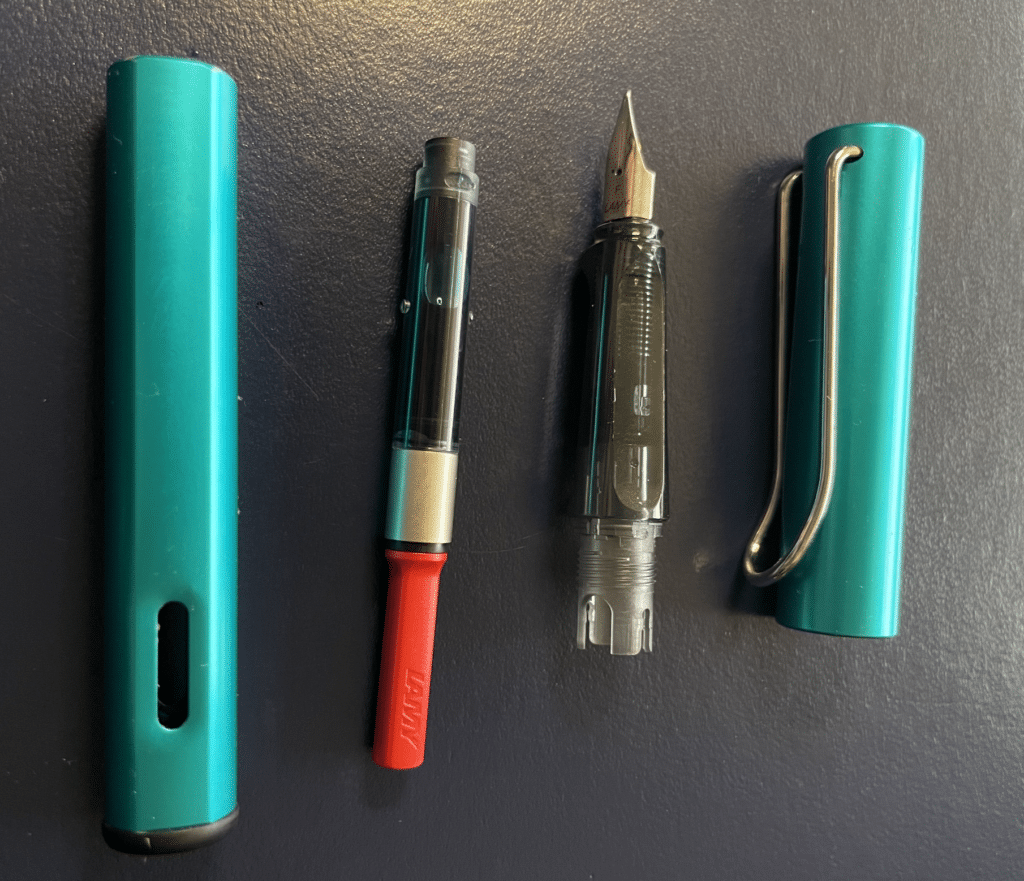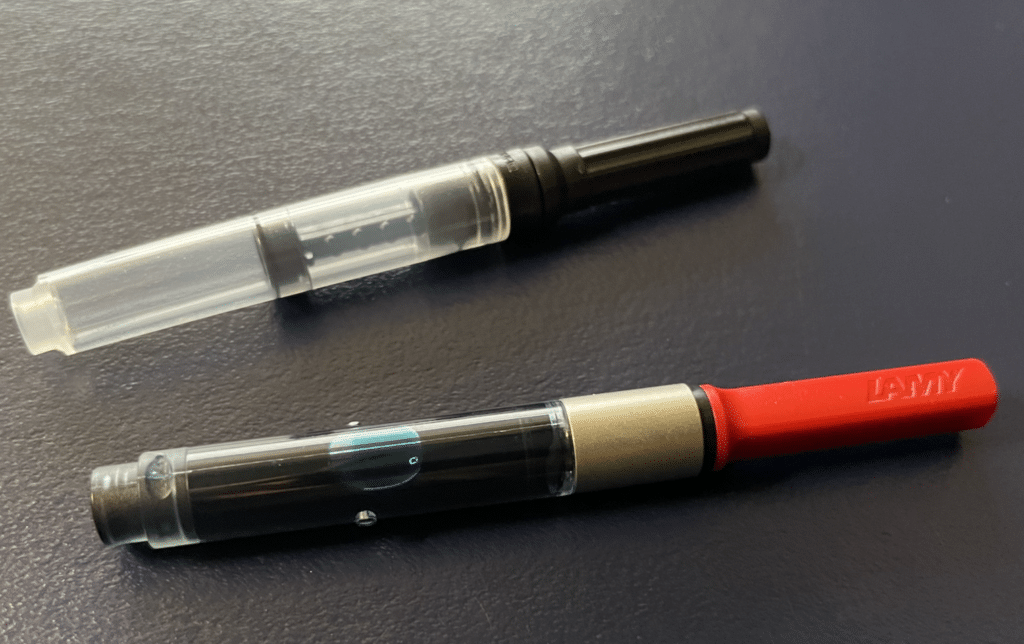There are many ways to fill a fountain pen with ink. The three most popular are piston-filled, cartridge, and converter ink pens.
A converter pen is a nice hybrid between piston and cartridge pens. Giving you more flexibility, affordability, and ease of use.
I’m a fan of converter fountain pens myself, so let’s say I’m partial to them.
So let’s dig into it.
What is a fountain pen converter?
A converter ink pen is basically a cartridge fountain pen with a removable ink reservoir that lets you fill the pen with bottled ink.
This post shares more about the anatomy of a fountain pen.
Most pens that use ink cartridges can also use converters.
The converter itself is a small, refillable piece that fits inside the pen’s barrel and attaches to the nib unit. It clicks right into the same spot you’d use for an ink cartridge.

This design offers the convenience of a cartridge pen and the flexibility of a piston-fill pen.
Types of fountain pen converters
There are a few different types of converters. But the most popular are piston-style converters and plunger-style converters.
They work basically the same way.
You either twist or pull on the end of the converter to create a vacuum and suck the ink up into it. Then to get ink out, push the plunger down or twist the piston converter in the opposite direction.
There are also squeeze converters which suck up the ink into a little sack, and push-button converters, which involve pushing a button on the converter over and over (annoying). But those two are less common.
Most beginner fountain pens work just fine with a piston or plunger-style converter. If I were you, I’d stick with those first to get the hang of it.
Download this cheatsheet and get expert solutions for the 13 most common pen problems.
Get The FREE CheatsheetThe perks (and negatives) of using converters
Ultimately, which type of fountain pen you use depends on your personal preference. When I was choosing my first fountain pen, I went with what was easy (and affordable).
So a cartridge pen that could be converted was the right pick for me.
Some people swear by a cartridge pen, while others wouldn’t touch anything that doesn’t have a piston system.
But, for many, a converter is a nice hybrid of the two, giving the following benefits:
- Flexibility. Converter pens offer the option to use cartridges and bottled ink, so you can snap in a trusty black ink and go or experiment with a couple of different colors.
- Ink variety. Something I love about fountain pens is exploring different types and styles of ink. With a converter, you have unlimited options.
- Environmentally friendly. Most people toss ink fountain pen cartridges after use (though you can actually refill them), so if you don’t love adding more plastic to the world, a converter can help.
Downsides of using converter pens:
- Limited ink capacity. Depending on your view, this is a good thing or a bad thing. Converters generally don’t hold a ton of ink, so you may have to refill them more often.
- Compatibility concerns. Some converters may not fit all pen models, so you’ll want to do some research before you buy.
- Maintenance. Converter pens require regular cleaning and maintenance, which can be time-consuming or annoying if you don’t like doing it often.
Navigating converter pen compatibility
Not all converters fit all pens.
It’s sort of like when you replace your phone a few times and end up with 17 different charges because none of them fit.

Pens are (sort of) the same way. Some use proprietary converters; for instance, my Lamy fountain pens need Lamy converters.
But a lot of popular brands, including Conklin, TWSBI, and Waterman, use a standard international or universal fountain pen converter. You can buy a couple of standard converters, and they’ll snap right into place in a variety of pens.
It just takes a minute to figure it out.
To ensure a perfect fit, consider:
- Pen brand. Start by looking for a converter designed specifically for your pen’s brand. Many pen manufacturers offer proprietary converters for their pens.
- Type of converter. There are various converter types, such as piston, squeeze, and twist converters. Research the best type for your pen model.
- Consult a pro. If in doubt, consult a fountain pen expert or retailer for advice on finding the right converter for your pen.
How to fill a fountain pen with a converter
Alright, if I’ve sold you on using an ink converter, you need to fill it.
The good news is it’s pretty easy.
Here’s how to put ink in your converter pen:
- Disassemble the pen. Unscrew the barrel from the section (the part that holds the nib and feed) and remove the ink cartridge if one is in there.
- Attach the converter. Gently insert the converter into the section, ensuring a snug fit.
- Fill with ink. Dip the pen’s nib into the bottled ink until the section is submerged. Operate the converter (twist or pull, depending on the type) to draw ink into the reservoir.
- Clean. Use a paper towel or soft cloth to clean excess ink off the nib.
- Reassemble and test. Screw the barrel back onto the section and test the pen on paper to ensure smooth ink flow.
If the mouth of your ink bottle isn’t wide enough to dip the nib, then you can still fill it.
I use my trusty blunt tip syringe and dip that in the ink. Then I’ll carefully fill the converter (outside of the pen) with the ink and snap it back into place.
You also may have to do this if you don’t have enough ink to submerge the nib.
Give a converter pen a try
As you get more into fountain pens, experiment with converters and cartridges. You may find yourself as a dedicated user of one or the other or switch them up when needed.
It takes a little bit of practice (especially at the start), but you’ll find that using converters can really expand some of the fun you can have with your pen.
Note this page contains affiliate links. If you click a link and buy one of the products on this page, I may receive a commission (at no extra cost to you!) This doesn’t affect my opinions or reviews of the products featured. Every review is as honest and unbiased as possible.
Liz
Hey, I'm Liz. I'm the founder of this thing. Pen-obsessed and a notebook nut, I love writing by hand. So I'm gonna talk about it on a computer.Download this cheatsheet and get expert solutions for the 13 most common pen problems.
Get The FREE Cheatsheet